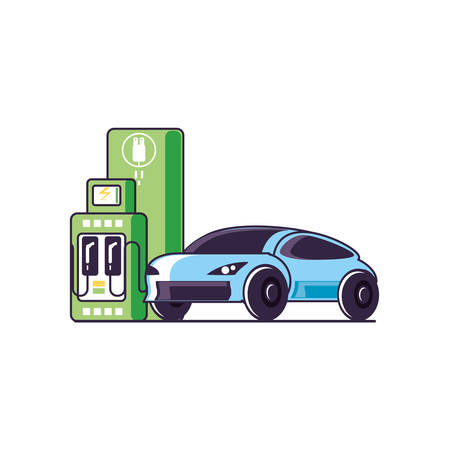Introduction to EV Depreciation in the UK
The depreciation of electric vehicles (EVs) in the UK second-hand market has become a hot topic among motorists, fleet operators, and industry experts alike. Unlike traditional petrol and diesel cars, EVs follow a different depreciation curve due to their unique technology, government incentives, and evolving consumer preferences. Typically, new cars lose value rapidly in the first few years, but EVs can experience either sharper or slower depreciation depending on several factors exclusive to the British market. Issues such as battery longevity, updates in charging infrastructure, fluctuating demand for used EVs, and ongoing regulatory changes all contribute to how quickly an electric car loses its value over time. Compared to their petrol and diesel counterparts, which have established resale patterns and broader buyer familiarity, used EVs are still carving out their place in the UK’s automotive landscape. Understanding these distinctive dynamics is essential for both buyers looking for a bargain and sellers hoping to maximise returns on their electric investment.
2. Key Drivers of Depreciation for Second-Hand EVs
The rate at which electric vehicles (EVs) lose value on the UK second-hand market is influenced by a complex mix of technical and market-driven factors. Understanding these key drivers is crucial for both buyers seeking value and sellers aiming to maximise returns.
Battery Health and Longevity
The condition and remaining capacity of an EV’s battery pack is the single most significant factor affecting its resale value. Unlike traditional combustion engines, batteries degrade over time and mileage, which can reduce range and performance. Prospective buyers often request detailed battery health reports, making well-maintained batteries with verified service records particularly valuable.
Manufacturer Reputation and Support
Brand trust plays a major role in depreciation rates. Established manufacturers with proven track records—such as Tesla, Nissan, and BMW—tend to retain their value better than lesser-known or discontinued brands. Ongoing manufacturer support, including software updates and warranty coverage, further reassures buyers.
Impact of Manufacturer Reputation on Resale Value
| Brand | Average 3-Year Depreciation (%) | Notable Factors |
|---|---|---|
| Tesla | 33% | Strong demand, regular software updates |
| Nissan | 38% | Widely available, good service network |
| Jaguar | 45% | Higher initial price, limited charging infrastructure |
| Lesser-known brands | 50%+ | Poor support, uncertain future parts availability |
Software Updates and Tech Obsolescence
The rapid pace of technological advancement can leave older EV models lagging behind in features or efficiency. Vehicles that continue to receive over-the-air software updates (a feature pioneered by brands like Tesla) maintain their relevance longer, whereas outdated infotainment systems or limited compatibility with new charging standards can quickly erode value.
Range Anxiety and Charging Infrastructure
Range anxiety remains a concern among UK buyers. Models with limited real-world range or those that cannot access the growing network of rapid chargers are more likely to depreciate quickly. Conversely, EVs boasting longer ranges and compatibility with popular charging networks command stronger resale prices.
Government Policy and Incentives
The UK government’s stance on low-emission vehicles continues to shape the used EV market. Changes to grants, road tax exemptions (VED), or clean air zone regulations can either buoy or dampen demand overnight. For example, phased reductions in plug-in car grants have already influenced buyer sentiment and pricing trends.
Summary Table: Key Depreciation Drivers for Used EVs in the UK
| Factor | Description | Effect on Depreciation Rate |
|---|---|---|
| Battery Health | Affects range/performance; visible via diagnostics | High impact if degraded; low impact if healthy & certified |
| Manufacturer Reputation | Status & support from brand; ongoing updates & warranties matter | Trusted brands hold value better than niche/unproven ones |
| Software/Tech Updates | Frequency of updates & tech obsolescence risk | Lack of updates accelerates depreciation significantly |
| Range & Charging Access | Total usable miles per charge; network compatibility/availability in UK cities & rural areas | Poor range/support leads to faster depreciation |
| Government Policy | Incentives/grants/tax breaks; regulation changes | Sensitive to policy shifts; positive policies slow depreciation |
Buyers and sellers alike should carefully assess these factors when entering the second-hand EV market, as they collectively determine how quickly an electric vehicle will lose its value on British roads.

3. Current Market Trends and Price Drops
The UK’s second-hand EV market has experienced significant shifts over the past year, with depreciation rates becoming a hot topic for both buyers and sellers. One of the key drivers behind this trend is the increased supply of used electric vehicles, as more early adopters upgrade to the latest models or switch brands. This influx has expanded choices for buyers but also intensified competition among sellers, resulting in steeper price drops than previously seen.
Another critical factor is the continuous launch of new and improved EV models by leading manufacturers. With each fresh release boasting longer ranges, faster charging times, and updated tech features, older models quickly lose their appeal, accelerating their depreciation curve. For instance, the introduction of affordable long-range options like the MG4 or the latest iterations from Volkswagen and Hyundai has placed downward pressure on prices for outgoing models such as early Nissan Leafs or Renault Zoes.
Changing consumer preferences are also shaping market dynamics. British motorists are becoming increasingly discerning, prioritising vehicles with robust battery warranties, reliable service histories, and advanced infotainment systems. As a result, used EVs lacking these features tend to see sharper value declines. Conversely, well-specced cars with remaining manufacturer support hold their value better in this competitive environment.
It’s worth noting that economic uncertainty and evolving government incentives further influence buyer confidence. Fluctuating energy prices and ongoing discussions about future road taxes or congestion charge exemptions create an atmosphere where some consumers hesitate, waiting for clearer signals before committing to a purchase. This hesitancy can lead to temporary oversupply and further drive down resale values in certain segments.
In summary, today’s UK used EV market is defined by rapid change: greater supply, technological leaps, and evolving buyer expectations all contribute to faster depreciation cycles. Both prospective buyers seeking bargains and current owners considering selling should stay alert to these trends to make informed decisions in a shifting landscape.
4. Regional Variations Across the UK
Depreciation rates for second-hand electric vehicles (EVs) are far from uniform across the UK, with several regional factors at play. Understanding these differences is crucial for both buyers and sellers seeking to maximise value or make informed choices. Key influences include charging infrastructure availability, local government incentives, and the urban-rural divide in EV demand.
Charging Infrastructure: A North-South Divide?
The density and reliability of public charging points can significantly impact an EV’s desirability and thus its depreciation rate. Urban centres like London, Manchester, and Birmingham typically boast a higher concentration of rapid chargers compared to rural Scotland or Wales. This accessibility often translates into stronger resale values in metropolitan areas, where range anxiety is less of a concern.
| Region | Average Public Charging Points per 100,000 People | Typical EV Depreciation Rate (Year 1) |
|---|---|---|
| London | 130+ | 15% |
| South East | 90 | 17% |
| North West | 70 | 19% |
| Scotland (Rural) | 40 | 22% |
Local Incentives and Policies
Councils in certain areas offer additional perks for EV owners—such as reduced parking fees or congestion charge exemptions—which can enhance appeal and slow depreciation. For example, London’s Ultra Low Emission Zone (ULEZ) not only makes owning an EV more cost-effective but also increases demand for used models within the capital.
Summary of Key Local Incentives:
| City/Region | Main Incentive |
|---|---|
| London | No ULEZ charge for EVs; discounted parking in some boroughs |
| Bristol | Free or reduced-cost parking permits for EVs |
| Greater Manchester | Access to Clean Air Zones without charge |
The Urban vs Rural Perspective
The adoption curve for EVs is notably steeper in cities due to shorter average commutes, better infrastructure, and heightened environmental awareness. In contrast, rural regions face barriers such as limited charging options and longer travel distances, contributing to higher depreciation rates for used EVs outside major urban hubs.
What This Means for Buyers and Sellers
If you’re looking to buy a second-hand EV, targeting regions with robust infrastructure and active local incentives may offer better residual value. Sellers in rural areas may need to price more competitively or highlight unique features like extended range or home charging solutions to attract buyers. Ultimately, regional market dynamics should be a core consideration in any used EV transaction within the UK.
5. Top Tips for Buyers and Sellers
Navigating the depreciation curve in the UK’s second-hand EV market can be tricky, but with the right approach, both buyers and sellers can secure a better deal. Here are some practical pointers tailored to the British market.
For Buyers: Getting Value for Your Money
Check Battery Health and Warranty
Battery condition is paramount—request a battery health report and check if there’s any remaining manufacturer warranty. Some brands offer battery coverage up to 8 years or 100,000 miles, which can save you a fortune on future repairs.
Research Residual Values
Not all EVs depreciate at the same rate. Models from established brands like Tesla or Nissan Leaf generally hold their value better due to stronger demand and reliable support networks. Use resources like Auto Trader or What Car? to compare how different models stack up in terms of depreciation.
Scrutinise Service History
A full main dealer service history adds confidence, especially as buyers become more EV-savvy. Look for evidence of regular maintenance, software updates, and MOT certificates to ensure you’re not inheriting someone else’s problems.
Factor in Charging Capability
Check if the car is compatible with rapid charging infrastructure common across UK motorways. A vehicle limited to slow charging could be less appealing—and worth less—in the long run.
For Sellers: Maximising Resale Value
Keep Software Up-to-Date
Manufacturers regularly release software updates that improve range, efficiency, and safety features. Make sure your EV is fully updated before listing it for sale—buyers increasingly expect this as standard.
Present Documentation Clearly
Organise your service records, MOT certificates, and charging cable receipts. Transparency reassures buyers and justifies a higher asking price.
Time Your Sale Strategically
The used EV market tends to heat up in spring and autumn when new registrations prompt upgrades and more trade-ins. Selling during these periods can mean a quicker sale at a better price.
Highlight Home Charging Benefits
If you’re including a home wallbox charger with the sale, make sure to mention it prominently—this can give your listing an edge, as installation costs are often a barrier for prospective buyers.
General Advice: Stay Informed
The UK’s EV landscape is evolving rapidly with new models, government incentives, and changing public attitudes. Whether buying or selling, stay abreast of news from trusted sources like The AA or Zap-Map to ensure you’re making informed decisions in this fast-moving market.
6. Future Outlook: What’s Next for Second-Hand EV Depreciation?
The landscape of second-hand EV depreciation in the UK is set to evolve dramatically over the coming years, shaped by a cocktail of government policies, rapid advancements in battery technology, and shifting economic tides. Both buyers and sellers need to keep a sharp eye on these factors to make informed decisions as the market matures.
Government Regulations: Incentives and Restrictions
One of the most significant influences on used EV values will be future government regulations. The UK’s commitment to banning new petrol and diesel car sales by 2035, alongside expanding low-emission zones in major cities, is expected to boost demand for all-electric vehicles—including second-hand models. Further incentives or grants for used EVs could narrow depreciation gaps even more, while stricter emissions standards may cause older petrol and diesel vehicles to lose value at an accelerated rate, making pre-owned EVs comparatively more attractive.
Battery Technology: Longer Life, Higher Value
Battery longevity has long been the elephant in the room when it comes to used EVs. However, as manufacturers continue to extend battery warranties and introduce advances such as solid-state technology, second-hand buyers can expect less degradation anxiety. Improvements in battery recycling and refurbishment are also likely to support residual values. As confidence grows that batteries will last well beyond 100,000 miles, depreciation rates should start aligning more closely with traditional internal combustion cars—or even outpace them in terms of value retention.
Economic Trends: Affordability and Market Dynamics
The broader economic picture will also play a critical role. If inflation remains high or borrowing costs increase, affordability could become a stumbling block for many buyers—potentially softening demand and accelerating depreciation temporarily. Conversely, as more affordable new EVs enter the market and supply chains normalise, we’re likely to see greater churn in the used sector. This increased supply could stabilise prices but also give consumers more negotiating power.
Market Predictions: A Balancing Act
Looking ahead, experts predict that while early adopters may have seen sharper losses on pioneering EV models, newer second-hand EVs are likely to fare much better thanks to improved reliability and mainstream acceptance. With public charging infrastructure expanding rapidly across the UK and insurers offering competitive premiums for zero-emission vehicles, both private buyers and businesses are expected to show sustained interest in nearly-new electric cars.
In summary, while some volatility is inevitable as the sector matures, all signs point towards a future where depreciation on second-hand EVs becomes less daunting—and potentially offers smarter value than ever before for savvy UK motorists willing to embrace change.


